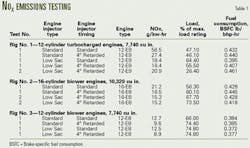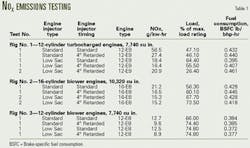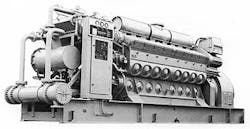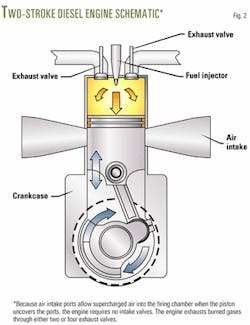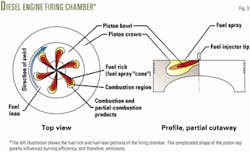As part of an overall environmental strategy initiated 2 years ago to reduce its environmental "footprint" worldwide, Noble Corp., Houston, has targeted its diesel-powered drilling rigs for total environmental impact monitoring and emissions control.
Early results of emissions-control efforts have shown that new diesel-injection technology reduces fuel consumption and NOxemissions (Table 1). The use of commercially available fuel injectors, constructed with a "low sac" design, and engine injector-timing retardation are the key elements of the company's rig-engine efficiency program.
Nitrogen oxide (NOx) emissions have decreased 30% under the new program. Fuel consumption has gone down by 2%, a cost reduction that will amount to an average of $5,000/year for each engine, for a total savings of about $270,000/year passed on to the operating companies.
In an extension of its initial program to improve rig efficiency, Noble is installing permanent monitoring devices on four engines of an operating rig to track sulfur, NOx, and carbon dioxide (CO2) emissions continuously during operation.
Pending results of the experiment, the company could install the devices throughout its global drilling fleet.
Rig fleet
Noble operates 53 offshore drilling rigs around the world, with 32 of the rigs employing locomotive-type diesel engines (Fig. 1). The engines drive 600-v AC generators connected to a common buss. The AC current, converted to DC current, drives the rig machinery such as the drilling motor, mud pumps, and winches.
The engines may contain 8, 12, 16, or 20 cylinders, with total engine displacement of 5,160, 7,740, 10,320, or 12,900 cu in., respectively.
Diesel engine operation
Diesel engines fire from the heat of compression and need no ignition spark as in the case of a gasoline engine.
On the compression stroke, the piston compresses about 16 volumes of air into 1 volume. The rapid compression into such a small space superheats the air, the fuel injector for that cylinder sprays the fuel from its reservoir into the combustion chamber, and the fuel ignites.
Because the low-sac injector holds only the amount of fuel required for combustion and power, the engine leaves no excess fuel in the injector after firing.
Injectors holding more fuel than the engine injects at each firing tend to lose the unburned fuel into the combustion chamber on subsequent strokes of the engine's cycle, resulting in release of unburned gases.
The presence of unburned gases in the exhaust indicates less than optimal fuel efficiency and pollutant release.
Diesel combustion consists of a series of complicated physical and chemical events that the engine's design and operation can affect or alter.
The sequence and rate at which these events occur are strongly related to the kinds and quantities of pollutants formed during combustion.1 Noble's success in reducing emissions and increasing fuel efficiency resulted from a combination of injector design and altered engine-injector timing.
Four stroke, two stroke
The typical diesel engine used in offroad applications operates on a four-stroke cycle consisting of the intake stroke, compression stroke, power or combustion stroke, and the exhaust stroke. Noble has chosen to use the two-stroke diesel in its drilling fleet.
Each cylinder of a two-stroke diesel engine fires once for every revolution of the crankshaft, as opposed to once for every two revolutions in a four-stroke engine. The two-stroke engine, therefore, has the potential to produce twice as much power as a four-stroke engine of the same size.
The two-stroke engine design is not a perfect match for gasoline engines. Unburned fuel leaks out each time the engine recharges its cylinders with the air-fuel mixture.
The two-stroke design is more appropriate for a diesel engine, where only air is compressed. Many large diesel engines are of two-stroke design.
Fig. 2 illustrates the two-stroke diesel engine design and function:2
- Starting with the piston at the top of its travel, the firing chamber is filled with highly compressed air. The injector sends fuel into the chamber in a fine spray, which ignites from the heat of compression.
- The explosion pushes the piston down in the power stroke.
- As the piston travels down, exhaust valves open to allow exhaust gases out.
- As the piston nears the bottom of its stroke, it uncovers air-supply ports, where turbocharged or supercharged air fills the cylinder. The new air coming into the cylinder forces the remaining exhaust gases out.
- The exhaust valves close and the piston comes up on its compression stroke. The cycle begins again with a new power stroke.
Two-stroke diesel engines require use of a turbocharger or supercharger to ensure delivery of enough air in the short exposure time available as the piston travels by the air-supply ports in the cylinder wall (Fig. 2).
Nitrogen oxides
Diesel engines create nitrogen oxides from molecular nitrogen (N2) and oxygen (O2) in the stoichiometric combustion region of the diffusion-controlled diesel combustion process.
Stoichiometric combustion occurs when air and fuel in the mixture are perfectly balanced so there is no unburned fuel or oxygen remaining.
A fraction of the nitrogen will dissociate, at the high temperatures present in the combustion zone, forming radicals that can then combine through a series of reactions to form the primary NOxconstituent, nitric oxide (NO). Nitrogen dioxide (NO2), another NOxconstituent, forms from NO in the flame region.
The NOxformation rate has a strong exponential relationship to temperature; high temperatures result in high NOxformation rates.3
Any changes to engine design that can lower the peak temperature occurring during combustion, lower dissociated nitrogen and oxygen partial pressures, or shorten the duration of these peak temperatures can lower NOxemissions.
The combustion event, which provides the energy for engine operation, starts at the end of the compression stroke and continues through the first half of the power stroke.
Near the end of the piston's compression stroke, the injector sprays fuel into the cylinder at high pressure, which mixes with the cylinder's contents. Technicians refer to this period of premixing as ignition delay.
Ignition delay ends when the premixed cylinder contents self-ignite from the high temperature and pressure produced by the compression stroke. The contents burn in a relatively short, homogeneous, premixed combustion event.
Immediately following premixed combustion, diesel combustion becomes primarily nonhomogeneous and diffusion-controlled, where the rate of fuel and oxygen mixing limit the combustion rate.
Fuel injection continues during this combustion phase, creating a region that consists only of fuel. Fuel diffuses out of this region as air enters it, creating a balance that supports combustion. Fuel burning occurs primarily in this region.
Fig. 3 illustrates the points. One way to visualize the phenomenon is roughly to divide the cylinder contents into fuel rich and fuel-lean sides of the reaction zone where combustion takes place.
Timing retardation
Delaying the start of fuel injection by retarding engine injector timing delays the start of combustion and significantly reduces the NOxemissions from a diesel engine. The industry has well established the effects of engine timing on emissions and performance.4-7
Delaying the start of combustion by retarding injection timing aligns the heat release from fuel combustion with the portion of the power (or combustion) stroke of the engine cycle after the piston has begun to move down.
At that point, the cylinder volume begins increasing as the piston moves down, enlarging the chamber. The engine extracts work, and therefore heat, from the expanding hot gases.
Removal of heat through expansion lowers the temperature of the combustion gases, reducing NOx, because it shortens the premixed burning phase and it lowers the cylinder temperature and pressure.1
Ordinarily, timing retardation increases fuel consumption because the end of injection comes later in the combustion stroke, which shortens the time for extracting energy from the fuel consumption.
Because Noble combines use of the low-sac fuel injectors with a timing retardation of 4° (standard timing was 4° before top dead center, so new timing is at top dead center of the No. 1 piston travel), however, the end result is lower NOxemissions and better fuel economy.
The combination of low-sac injectors and retarded timing has not diminished engine response or power output.
Testing
To conduct its testing program, Noble retained an independent testing and standards company to visit three of the company's rigs and test the engines under load and running under normal operating conditions.
The company that Noble retained tested 12 and 16 cylinder turbocharged and blower (supercharged) engines (Table 1). These enormous engines have a cylinder volume, calculated as bore diameter multiplied by crankshaft stroke length, of 645 cu in./cylinder.
Table 1 reveals some interesting observations:
- The best efficiency, in terms of both fuel economy and decreased emissions, occurred when the engines were well loaded. Noble considers 75% drilling load to be optimum for engine performance.
- When the engine load was kept a constant percentage of its rated load, as in the rig No. 3 tests, timing retardation caused a slight but almost negligible increase in fuel consumption.
The results presented in Table 1 lead to the following conclusions:
- Installing low-sac injectors and retarding the engine injector timing by 4° from standard timing decreased bothNOxemissions and fuel consumption.
- The locomotive diesel engines that Noble uses in its drilling fleet function most efficiently when loaded to 75% of the rated load capacity.
References
- "Nonroad Diesel Emission Standards," US Environmental Protection Agency paper EPA420-R-01-052, October 2001.
- Brain, M., "How two-stroke engines work," Marshall Brain's Howstuffworks website, www.howstuffworks.com/diesel-two-stroke1.htm, retrieved June 10, 2002.
- Heywood, J.B., Internal Combustion Engine Fundamentals, McGraw Hill 1988, pp. 572-78.
- Herzog, P., et al., "NOx Reduction Strategies for DI Diesel Engines," Paper No. Society of Automotive Engineers (SAE) 920470, 1992.
- Uyehara, O., "Factors that AffectNOxand Particulates in Diesel Engine Exhaust," Paper No. SAE 920695, 1992.
- Durnholz, M., Eifler, G., and Endres, H., "Exhaust Gas Recirculation-A Measure to Reduce Exhaust Emission of DI Diesel Engines," Paper No. SAE 920715, 1992.
- Bazari, Z., and French, B., "Performance and Emissions Trade-Offs for a HSDI Diesel Engine-An Optimization Study," Paper No. SAE 930592, 1993.
The author
Clyde J. Boudreaux Jr. is the maintenance manager for Noble Drilling (US) Inc. He is responsible for technical and maintenance support for Noble's US and international rig divisions. During his 39-year career with Noble Drilling, he has held several supervisory maintenance positions including directing maintenance support personnel and facilities in the US and international division sites.
